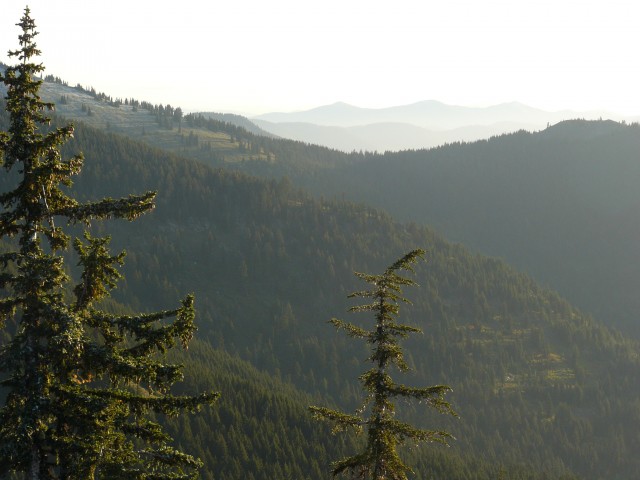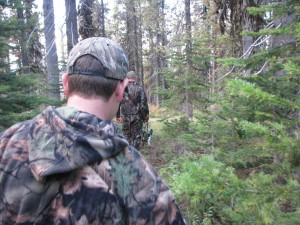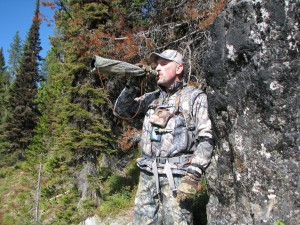Aggressive Elk Calling
 I mopped my brow as I descended the steep and unforgiving ridge in the hot midday sun. My purpose for subjecting myself to this torture is no more peculiar than why I bugle in my sleep. I’m an elk addict. There was a bull bugling his head off way down on the other side of this hell hole, and I was aiming to call him into bow range. Holding my cards close, I didn’t call again until I felt my position was right. Weighing my options of meat retrieval all by myself also took some precedence on how far down I was willing to go. Setting up about three hundred yards across the draw as the crow flies from the bull I called to him hoping he would come charging across the ravine to meet his end. I really couldn’t cross the draw and get on his turf because of #1) it was an impenetrable, brushy mess, and #2) I had skipped work that day and had to go back to work at 6am the next morning. Snapping back to reality, the bull screamed in return. And that was the way it went for the next 2 hours. I would call and he would reply. I was on a fairly open, hot and sunny ridge, and he was in his nice cool north facing “hidey hole”. I gave up, and headed back up the steep mountainside to my pickup.
I mopped my brow as I descended the steep and unforgiving ridge in the hot midday sun. My purpose for subjecting myself to this torture is no more peculiar than why I bugle in my sleep. I’m an elk addict. There was a bull bugling his head off way down on the other side of this hell hole, and I was aiming to call him into bow range. Holding my cards close, I didn’t call again until I felt my position was right. Weighing my options of meat retrieval all by myself also took some precedence on how far down I was willing to go. Setting up about three hundred yards across the draw as the crow flies from the bull I called to him hoping he would come charging across the ravine to meet his end. I really couldn’t cross the draw and get on his turf because of #1) it was an impenetrable, brushy mess, and #2) I had skipped work that day and had to go back to work at 6am the next morning. Snapping back to reality, the bull screamed in return. And that was the way it went for the next 2 hours. I would call and he would reply. I was on a fairly open, hot and sunny ridge, and he was in his nice cool north facing “hidey hole”. I gave up, and headed back up the steep mountainside to my pickup.
Sound familiar? How many times have we heard a friend talk about how they had bulls bugling all season, but never could seal the deal? Each year many hunters walk away from a good thing that’s just waiting for the right moves to be made. Yes, you may have a bull gallop across the canyon with a death wish after a couple well made calls. But the bulk of successful bull interactions happens when the hunter takes the game to the elk, not vice versa. We’re not talking about chasing elk out of the country. But more of being proactive, not reactive.
Close the Gap

Aggressive elk calling begins with a “can do” attitude. Once you have made contact with the bull and have a good idea of where he’s standing, its “go time”. Closing the gap quickly is imperative. A hunter needs not to be “Elmer Fudd” quiet when heading a great distance to the bull. As I walk briskly, or even sometimes jog towards the bull, I may let out a very quiet cow call periodically just in case a nearby bull hears me and wants to join in on the fun. As long as the sounds your making are natural while your crunching and snapping through the forest, you will be fine. Avoid talking and clinking metal noises as they dont fit into nature. Once you get into the bull’s red zone its time to tone down your noise level and look for the perfect place to set up. Don’t call until you have a good hiding place and a quiet place to stand.
Aggressive Calling

Some may say, “call very sparingly, and quietly too” when calling in a bull elk. Aggressive calling is not quiet or reserved. Think of an argument between two belligerent men. It all starts with a simple word or two being exchanged and it then builds up to a shouting match followed by “fisticuffs”. When a bull elk’s excitement rises, he may bugle every 10 seconds and in high volume too. Let your calls build with the temperature of the argument. If he is screaming at everything you throw at him, cut him off with a challenge bugle until he barges in to lay the smack down. If you know he’s committed, on the move and coming in, that’s the time to clam up and make him seek you out. If things go a bit wrong and he moves away, follow like you haven’t had enough yet and put some pressure on him by calling aggressively. It may be just enough to turn on his fight instinct and have him come right in to easy archery range.
Looking back I should have kept going gown that nasty steep canyon that day. I’m sure the boss man would have been ok with some fresh back-straps for his dinner plate as a bribe for a second day off! If you go hunting this fall with an attitude of “I’m going to make something happen”, instead of “I’m going to hang out and see what happens”, you will have much more adventure in your hunt and quite possibly, a notch in your elk tag. Hunt hard and be aggressive!
